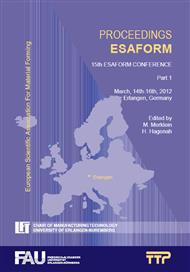p.225
p.231
p.237
p.243
p.249
p.255
p.261
p.267
p.273
Simulating the Manufacturing Process and Subsequent Structural Stiffness of Composite Wind Turbine Blades with and without Defects
Abstract:
Traditional ply-based and zone-based models are limited in their ability to account for the fiber directions resulting from the forming of fabric-reinforced composite wind turbine blades. Compounding the problem is the presence of defects such as resin-rich pockets of the polymer matrix due to out-of-plane and in-plane waves resulting from the manufacturing process. As a result, blades are typically overdesigned, unnecessarily increasing weight and material costs. In the current research, a methodology is presented for simulating the manufacturing process for fabric-reinforced composite wind turbine blades using ABAQUS/Explicit. The methodology captures the evolution of the yarn directions during the forming process thereby allowing for a map of the fiber orientations throughout the blade. A hybrid approach using conventional beam and shell elements is used to model the various fabric layers. Using experimental shear, tensile, bending, and friction data to characterize the mechanical behavior of the fabric layers, the model captures in-plane yarn waviness and changes in the in-plane yarn orientations as they conform to the shape of the mold, as well as out-of-plane wave defects as a result of the manufacturing process. Subsequently, after the fabric layers have been laid into the mold and the final yarn orientations are known, the structural stiffness of the blade resulting from the resin-infused fabrics can be calculated. The methodology can thereby link the resulting bending and torsional stiffnesses of the blade back to the manufacturing process. This paper discusses the methodology for determining the material properties of the beam and shell elements in their final orientations in the cured composite to predict the structural stiffness of a wind turbine blade.
Info:
Periodical:
Pages:
249-254
Citation:
Online since:
February 2012
Keywords:
Price:
Сopyright:
© 2012 Trans Tech Publications Ltd. All Rights Reserved
Share:
Citation:


